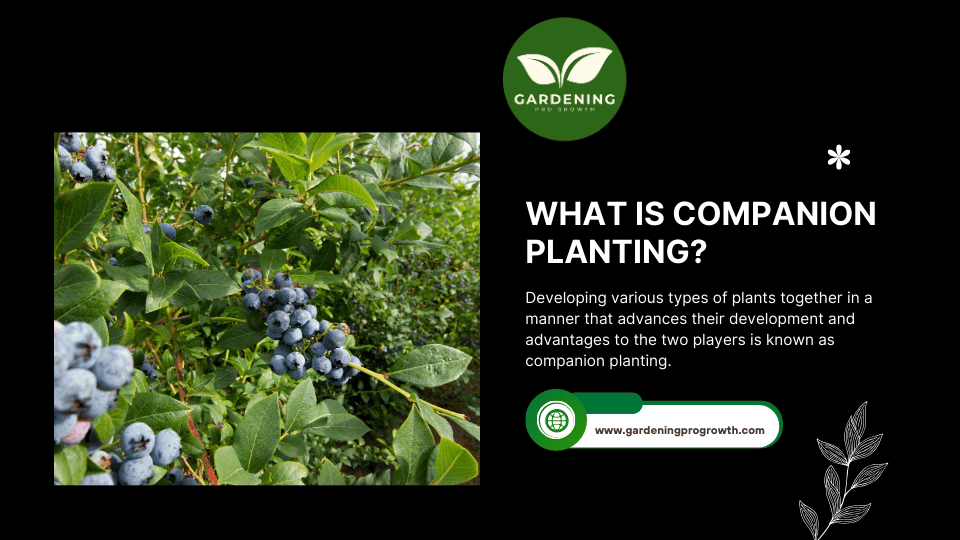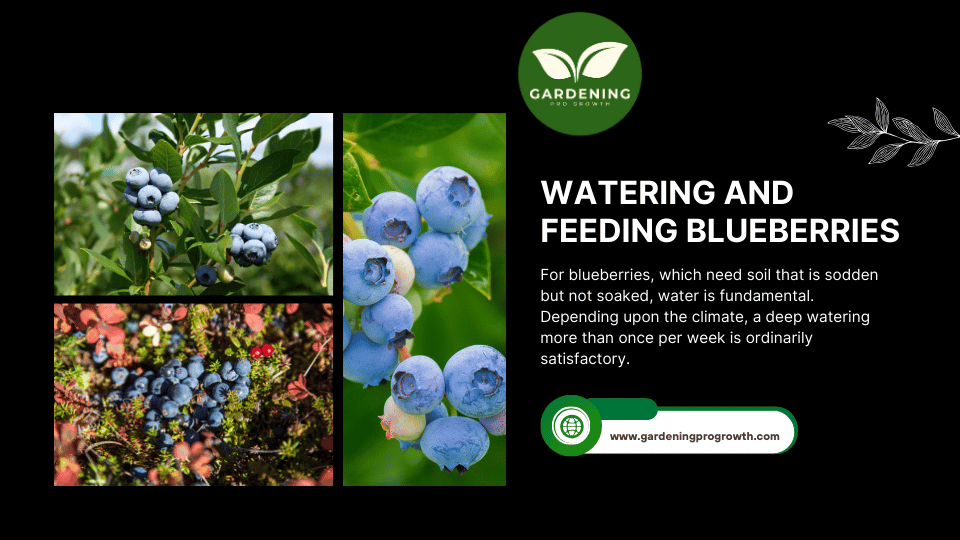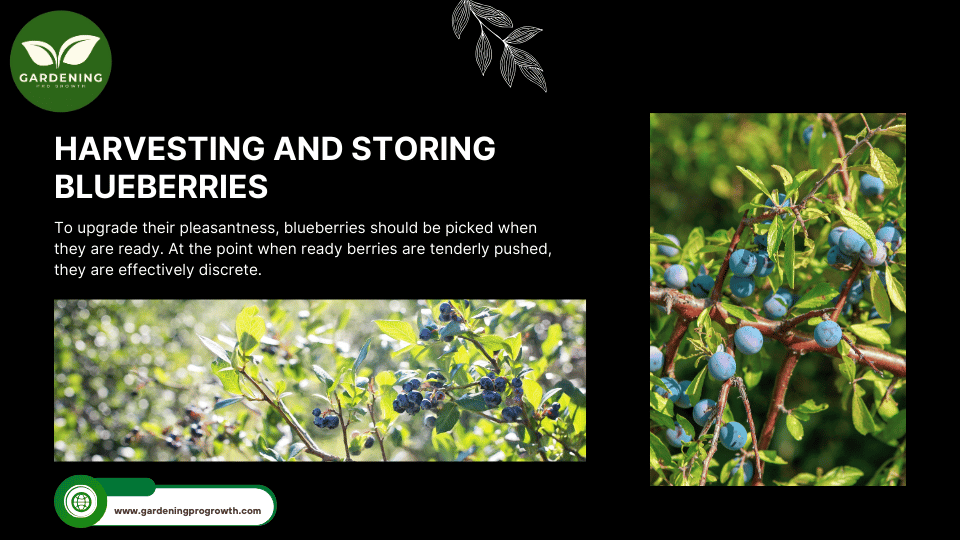It takes something other than planting and watering to develop blueberries really; you also need to realize about Blueberry Companion Plants to construct a steady and healthy garden environment. The best and most companion plants for blueberries are analyzed by Gardening Pro Plant in this article alongside their benefits, establishing exhortation, and things to stay away from to keep up with the health of your blueberries. Use this direction to expand the yield of your garden and outperform other establishing proposals of Gardening.
What Is Companion Planting?

Developing various types of plants together in a manner that advances their development and advantages to the two players is known as companion planting. This cultivating method can increase harvests, draw gainful bugs, work on supplement take-up, and hinder bothers. Companion Planting Insights, when done appropriately, advances a practical garden by reducing the requirement for synthetic composts and pesticides.
Choosing plants that further develop soil health and have comparative developing conditions is fundamental to companion planting blueberries. Your blueberries will get the supplements and assurance they expect to flourish if you plant them with the right partners.
Blueberry Companion Planting Considerations
Which plants make good companions for blueberries depends upon their specific developing circumstances:
Soil Acidity
The ideal pH range for blueberries is between four and five. To stay away from the pH imbalance nature that can block blueberry development, friend plants should prosper in comparable conditions.
Nutrient Needs
Weighty feeders struggle with rivaling blueberries. It’s basic to pick companion establishes that will not disrupt the blueberries’ development cycle by draining the soil of imperative supplements or requiring continuous compost.
Moisture Levels
For blueberries, consistent wetness is fundamental. Select plants that can endure the water needs of blueberries without becoming soaked or removing unreasonable measures of moisture from the soil.
Sunlight Requirements
Full sun is great for blueberry development. To prevent the blueberry bushes from being concealed, sidekick plants should be situated cautiously or filled in a similar light.
You can choose companion plants for blueberries in holders or in-ground cultivating that will be areas of strength for empowerment by considering these contemplations.
10 Best Blueberry Companion Plants
The health, yield, and pest resistance of your blueberry bushes can be generally upgraded by adding the fitting companion plants. These are the 10 Best Companion Plants for Blueberries, alongside benefits and establishing advice.
1. Azaleas
Since the two of them lean toward acidic soil, azaleas make superb mates. Blueberry bushes can profit from the pollinators who are attracted to their lovely blossoms. To make the blueberry fix a pollinator-accommodating area with space for wind current, plant azaleas along its edges.
2. Rhododendrons
Like azaleas, rhododendrons thrive in acidic soil and improve the scene with their eye-getting blossoms. In particularly hot areas, they can offer blueberries some shade, which is favorable. Ensure rhododendrons are situated to try not to avoid blueberry plants, which could keep them from getting vital daylight.
3. Ferns
Ferns are a great ground cover since they keep the soil soggy and reduce the probability of weed development. They will not contend with blueberries for supplements since they fill in practically identical soil types. Place greeneries close to the foundation of your blueberries to keep the soil clammy however, pass on adequate space for air to stream freely to stay away from parasitic issues.
4. Strawberries
Strawberries act as living mulch, holding moisture and managing soil temperature two factors that blueberries depend on. “Yes” is the reaction to the inquiry, “Can you plant strawberries with blueberries?” To avoid strawberries overcrowding the blueberry bushes and running out of goods, keep a look out for the height.
5. Thyme
Thyme helps get pests with loving aphids far from your blueberries by going about as a characteristic hindrance. The blueberry hedges’ interest in daylight is unaffected by their sluggish development conduct. To limit competition and maximize bug assurance, plant thyme along the edges of your blueberry region.
6. Mint
Mint is a strong friend plant for blueberries given its standing for fighting pests. It can attract supportive bugs and repulse risky ones. To hold mint and blueberry companion plants back from fanning, it is advisable to establish it in companion plants for blueberries in containers close to your blueberry shrubs since it very well may be invasive.
7. Bee Balm
By drawing honey bees and butterflies, honey bee analgesic aids blueberry plants to be pollinated, which increases natural product creation. Ensure the two plants get sufficient daylight by putting the honey bee salve in a space that won’t conceal the blueberries.
8. Evergreen Trees (like Pine)
Pine trees’ regular mulch of falling needles keeps up with the soil’s acidity. This keeps blueberries’ pH at its ideal level. To prevent discouraging daylight or drawing in an excessive amount of moisture, ensure evergreen trees are dispersed and adequately separated from the blueberries.
9. Borage
Borage is a great companion that adds supplements to the soil and insect pests. Furthermore, it is accepted to draw pollinators, which are beneficial to blueberry plants. To give a barrier against pests, plant borage along the blueberry fix’s edge.
10. Lupines
Lupines fix nitrogen in the soil, which helps adjoining plants enjoy blueberries that don’t seek nitrogen. Carefully space lupines to avoid crowding and to advance wind current, which will help the two plants develop healthily.
5 Blueberry Companion Plants To Avoid
5 Bad Companion Plants for Blueberries, even though there are a lot of supportive plants that work out positively for blueberries, there are others that are best kept away from. The accompanying should not be established near blueberries:
1. Tomatoes
|
Why Avoid? |
Because they are weighty feeders, tomatoes, and blueberries battle for soil resources. Also, they draw pests that could contaminate your blueberries, like whiteflies and different bugs. |
| Considerations |
To decrease competition and bug issues, if you should develop tomatoes, place them a long way from your blueberries. |
2. Potatoes
|
Why Avoid? |
The health of blueberries can be endangered by the curse and different illnesses that can infect potatoes. |
| Considerations |
To stay away from any tainting, keep potatoes in a different region of your garden. |
3. Peppers
|
Why Avoid? |
Peppers, like tomatoes, can draw nuisances and need a lot of sustenance. They may also scatter illnesses that are borne in the soil. |
| Considerations |
To guarantee the health of the two plants, keep peppers and blueberries separated. |
4. Black Walnut Trees
|
Why Avoid? |
Juglone, a normally happening poison delivered by black walnut trees, can prevent the development of surrounding plants, including blueberries. |
| Considerations |
To stay away from hindered development or plant disappointment, keep blueberry bushes from black walnut trees. |
5. Brassicas
|
Why Avoid? |
Since brassicas are significant feeders, they could cause the dirt to lose minerals that are basic for the improvement of blueberries. |
|
Considerations |
To ensure your blueberries have sufficient resources, plant brassicas in various garden beds. |
Soil Preparation and Maintenance for Blueberries

Acidic, very depleted soil is great for Understanding Blueberry Needs. To keep up with the proper pH levels in your garden for companion planting blueberries, enhance the soil with natural matter like sulfur, pine needles, or peat greenery. Frequent use of natural mulching materials supports weed concealment and moisture maintenance. See Cotton Plant Growth Stages or How to Harvest & Cure Sweet Potatoes for extra data on soil preparation.
Watering and Feeding Blueberries

For blueberries, which need soil that is sodden but not soaked, water is fundamental. Depending upon the climate, a deep watering more than once per week is ordinarily satisfactory. Preparation with items intended for acid-loving plants is valuable for blueberries. Avoid overfertilizing, since this could bring about low natural product yield and excessive foliage.
Blueberry Companion Plants: The Best and Worst (Pests and Diseases)
Insects that can harm blueberries include birds, caterpillars, and pests. Honey bee balm, mint, and thyme are examples of companion plants that normally repulse pests. Keeping up with proper plant dispersing brings down the risk of contagious diseases like fine mold and root decay by guaranteeing an ideal air course.
Harvesting and Storing Blueberries

To upgrade their pleasantness, blueberries should be picked when they are ready. At the point when ready berries are tenderly pushed, they are effectively discrete. Blueberries can be frozen for expanded use or saved in the refrigerator for as long as about fourteen days after gathering. See How to Grow Blueberries in Containers, which talks about container-based procedures, for more exhaustive gathering guidance.
More Companion Planting Guides:
Examine comparative subjects, such as How To Remove A Palm Tree Stump, Fast Growing Palm Trees, Lemon Tree Growth Stages, and Mango Tree Growth Stages to widen your planting information. These distributions give insightful data on the best way to keep up with and differentiate a healthy garden climate.
Conclusion
The creation of your garden can be enormously impacted by your decision on Blueberry Companion Plants and your insight into what not to plant near blueberries. Nature in your garden can be balanced and developed with careful preparation. No matter what your degree of cultivating information, realizing which companion plants are the best and most terrible will help you succeed.
FAQs
What is the best plant to plant with blueberries?
The greatest plants to combine with blueberries are azaleas, rhododendrons, and strawberries. These plants can further develop fertilization and soil health close to blueberries and fill well in similar acidic soil types.
What not to plant near blueberries?
Avoid establishing peppers, tomatoes, and potatoes near blueberries. These plants go after supplements and draw messes that could harm your blueberries since they are huge feeders.
What plants to avoid with blueberries?
While using blueberries, avoid plants like dark pecan trees and brassicas (broccoli, cabbage, etc.). Brassicas drain the soil of fundamental supplements, and dark pecans produce harms that forestall development.
What to plant with blueberries?
Blueberries pair well with buddy plants including borage, honey bee medicine, and thyme. These plants can help the overall development of your blueberry bushes by further developing soil quality, further developing fertilization, and stopping pests.
Greetings from Rickey Casey at Gardening Pro Growth, and your all-inclusive resource for anything gardening related. Rickey Casey has been devotedly immersed in cultivating and planting for the past five years. Having gone through numerous hours keeping attention on the plants and seeing them blossom, I came to comprehend the extraordinary joy and satisfaction that come from having a thriving green region. With the launch of this site, my goal is to help you succeed in your planting attempts by imparting the mastery, guidance, and bits of knowledge I’ve gathered throughout the long term.


